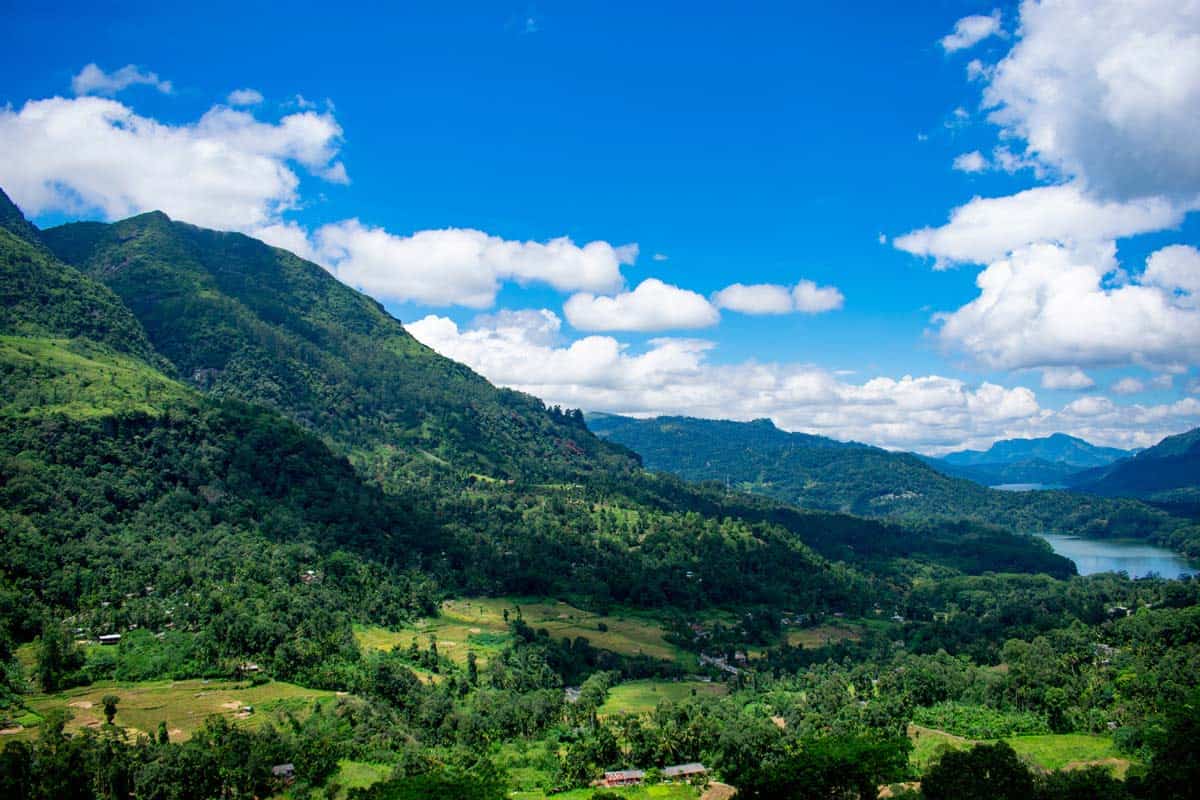
Starting the Journey
The stone steps grew steeper and narrower, climbing ever higher. As the hours passed, it seemed they would never end, fatigue and strain tearing at my muscles. Keeping up a steady pace and not stopping was the key. High up on the peak many were struggling, some literally using the railings to try to pull themselves up the holy mountain.
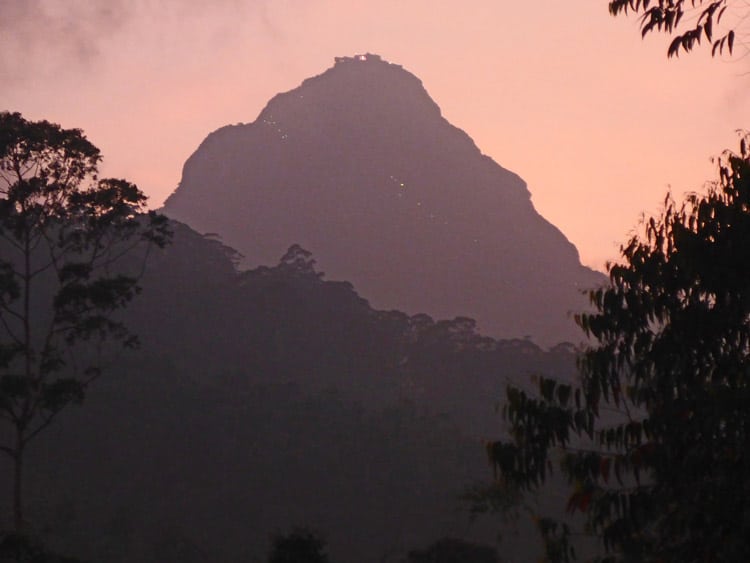
The 4.2 miles straight up to the summit of 7,359-foot Adam’s Peak didn’t seem that daunting to me. However, the final segment, the thousands of steep stone steps to the top of Sri Lanka’s legendary pilgrimage site, an incredible 5,500 of them, slowed even the youngest and fittest.
Buddhists, Hindus, Muslims and Christians all have deep-rooted religious ties to the mountain, so pilgrims suffer the grueling climb for their beliefs. Almost outnumbering the pilgrims these days are Westerners, mostly 20-somethings, who trudge up the mountain in the middle of the night just to be able to say that they did it.
Sri Pada (Adam’s Peak) is not only a soaring natural landmark but also one of Sri Lanka’s most revered places. The footprint discovered on the summit is claimed as Buddha’s by Buddhists (from one of his three visits to Sri Lanka); as the god Shiva’s by Hindus (who ruled the island more than two millennia ago), and as Adam’s by Muslims and Christians (his first step after being tossed from Paradise). The majority of the pilgrims, however, are Buddhists, including some from faraway lands.
Orientation at White House Hotel in Dalhousie
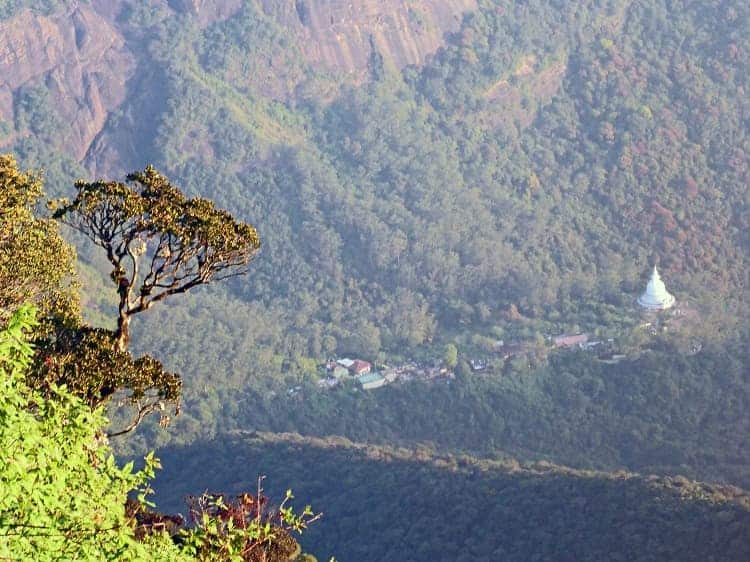
Weaving through precipitous hills carpeted with endless rows of tea bushes, riding in the back of a three-wheel tuk-tuk that often sped through the curves of the serpentine road on two wheels, I arrived at the White House Hotel in the village of Dalhousie, Sri Lanka.
Named for its imposing, four-story, white exterior, it was a bustling hub of activity with travelers of many nationalities coming and going. Every guest at the White House, and every other hotel in the area for that matter, was there for only one reason: to hike up Adam’s Peak.
All the guests gathered on the large open-air terrace in the evening for a tasty and extensive buffet dinner of Sri Lankan curries. Immediately after dinner, things got serious.
Niman, the hotel’s owner-manager, gathered his guests, as he does each evening during the December-March hiking season, around an 8-foot-tall illustrated map of Sri Pada to give a lively, somewhat cheeky, dissertation on climbing Adam’s Peak.
He established his credentials by professing to have hiked the peak 1,500 times and then proceeded to describe the route in detail, including the landmarks we would pass and when (to make sure we stayed on the right path), the thousands of challenging stairs, what we would find on top, etc. The hikers in the diverse group listened in awed silence but were apparently so intimidated by the mountain that they heard little.
Chit-chat With Our Guide: Niman
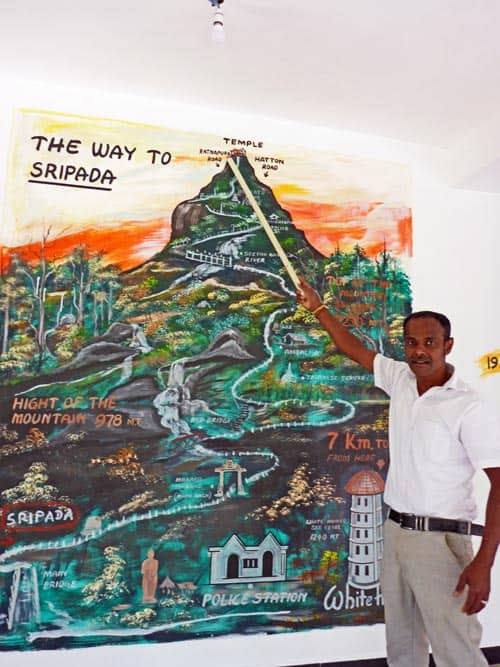
At one point Niman identified when we would pass a tall statue of Buddha and immediately cross a wooden bridge. Then he asked: “So what are we looking for at this place in the journey?” No one spoke up ‒ until I parroted what he had just told us. This scenario repeated itself several times.
I was the only one to answer his sarcastic, and obvious, questions ‒ earning me a series of high-fives from Niman. The travelers, a mix of Sri Lankans, various European nationalities, a group of Indonesian Buddhists and one Californian, were nervous. The mountain can do that to you.
Niman undoubtedly stoked some of that fear when he noted that the ascension was not so glorious for some:
“On a number of occasions over the years, foreigners have had to be stretchered off the mountain carried by porters, some Sri Lankans as well, because they took terrible falls or had heart attacks.”
He then pointed to a stack of walking sticks and recommended we use one, which I took him up on.
‘Watch Out For Pickpockets’
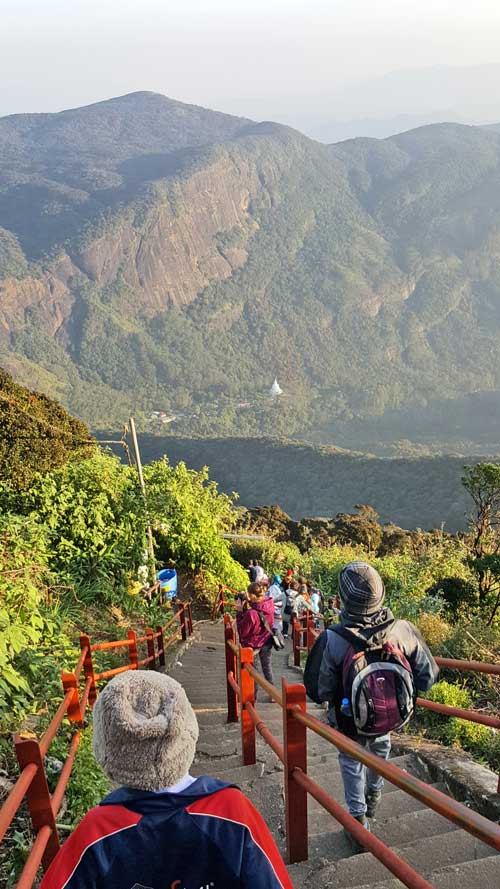
Surprisingly, his sternest warning was to, “watch out for pickpockets preying on pilgrims among the crowds on top.” As he put it: “Sri Lankans are good people” ‒ decidedly true, making it one of the safest places to travel ‒ “but among 100,000 there may be one bad person.” He advised us to carry nothing of value in our pockets and reverse day packs so they are in front rather than on our backs.
That was that. Everyone was now on their own to climb Sri Pada, most planning to head out around 2:30 a.m. to be sure of reaching the top in time for the reliably glorious sunrise.
Climbing to The Holy Mountain Upper Path
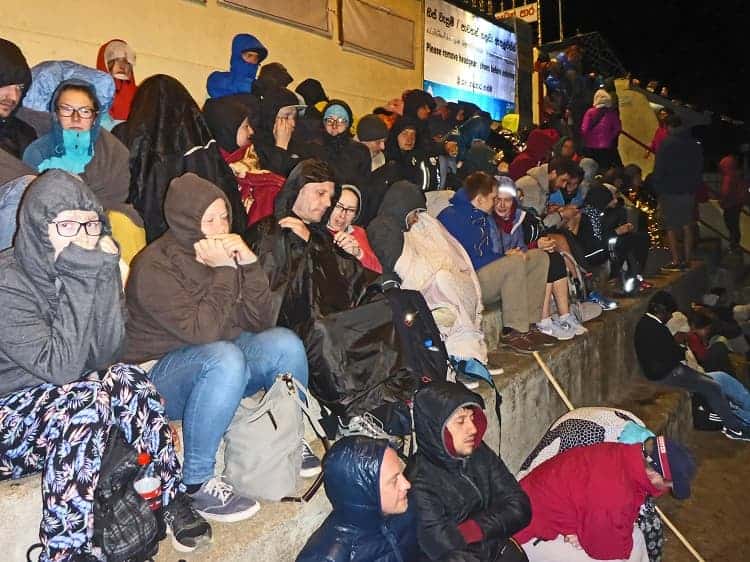
Much of the upper path (where the stone steps begin) is lit with fluorescent tubes and, in the lower portion, dotted with kiosks selling hot food and tea, tchotchkes and warm clothing. It was a festival-like atmosphere with a nightly parade of marching pilgrims and Westerners, with some 200 people the night I was there. The path was a teaser, rambling along at a gentle incline at first, lulling me into complacency, before beginning to climb a little, then more, and more.
The steps at first are widely spaced but become progressively sheerer and narrower. After thousands of steps, even the strongest hikers feel the effects: my pace slowed to a trudge, breath shortened with each step, legs began to ache, strength waned. My heart began pounding so hard that more than once it crossed my mind whether I was going to be the next foreigner to have a heart attack and be stretchered off the mountain.
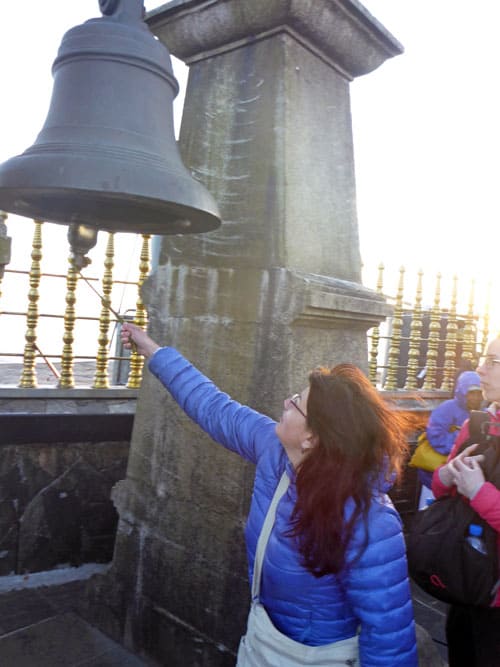
Suddenly, I could see the summit, only some 100 steps away. Just below the top, a Sri Lankan policeman, echoing what Niman had said, was telling all who passed to watch out for pickpockets. I had made it, in just 2 ½ hours, a very fast time. I was greeted at the summit by a fierce, freezing wind that blew right through my layers of clothing. Hiking up we were on the lee side of the mountain protected from the elements.
Adam’s Peak Summit is Worth it
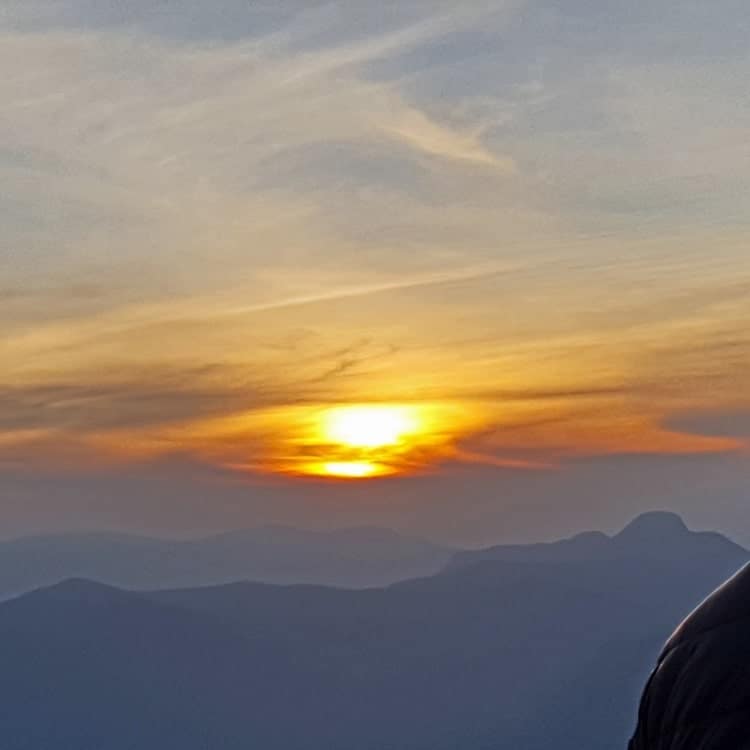
Reaching Adam’s Peak was anti-climactic. The summit houses only a few small shrines, strings of colored flags rippling in the wind, and several Buddhist bells ‒ you don’t even get to see the famous footprint because it’s hidden inside a protective metal cabinet. The sunrise was still nearly an hour away, so I crammed with other hikers into one of the few sheltered spots and shivered, awaiting the warmth of the new day.
Pinks and reds streaked the sky first, giving way to pale oranges before a blazing yellow ball broke the horizon. Jostling for the best views ‒ of mountains and forests in all directions ‒ pilgrims were madly capturing the spectacular 360-degree panoramas with their phone cameras (incongruously, it was Buddhist monks who had the professional cameras with sizable telephoto lenses). The sun’s emergence brought a glorious, bright and clear morning of shimmering colors.
Sudden Human Traffic
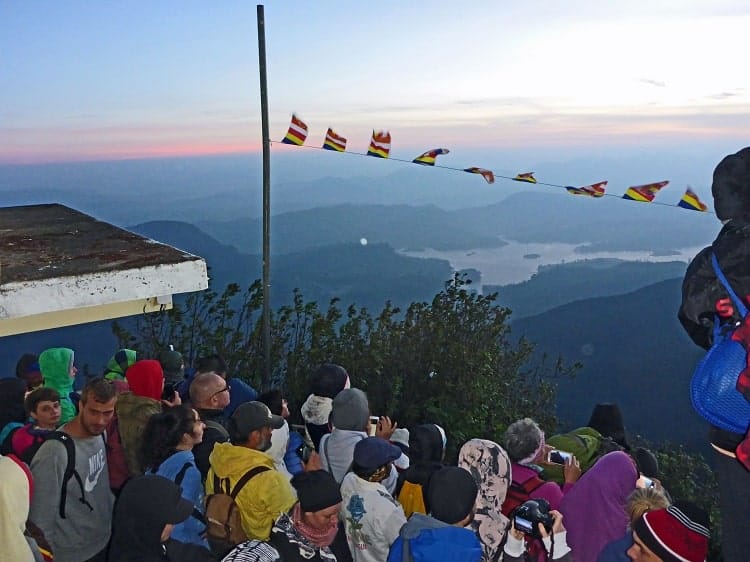
Within minutes, there was a mass movement to descend, creating a human traffic jam on the stairs. Few departed, however, without first ringing one of the bells; in fact, a line formed of pilgrims and hikers waiting to swing the ringer into the resonant iron bells. The purpose, as one Buddhist pilgrim explained, is to “wake yourself up” as you continue on your journey to find wisdom, compassion and the path to enlightenment.
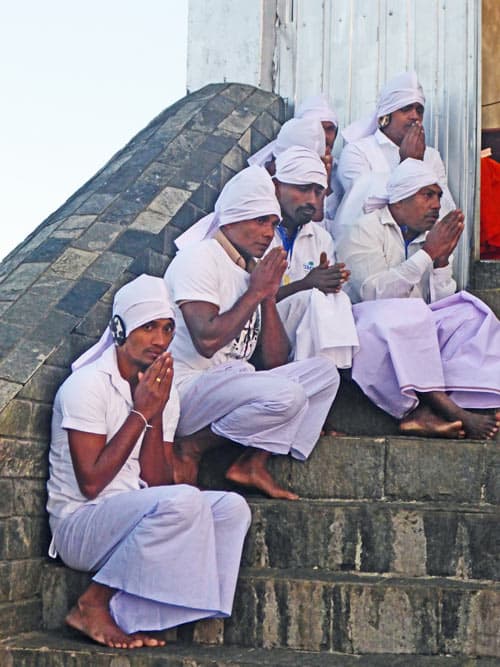
Was Adam’s Peak worth the draining exertion, loss of sleep, aching legs and knees, the brutal cold? Absolutely. It was a seminal experience that defined my trip to Sri Lanka, a spiritual as well as a physical journey with people from many nations, connecting with the country’s multi-cultural, multi-religion persona.
Plus, for the rest of my life I can say I climbed to the spot of Adam’s first step after being ejected from the Garden of Eden.
Explore more of the vivid colors of Sri Lanka: Watch the video here
- How to Get Around in Sydney: A Local’s Guide to Traveling Around Sydney - April 24, 2024
- The Low-Key Magic of Ghent, Belgium - April 22, 2024
- Discover the Hidden Charm of Extremadura in Spain - April 20, 2024
